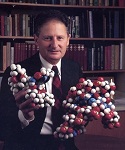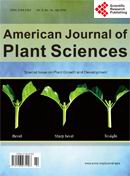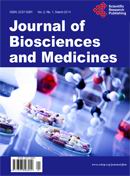
Biography

Henry M. Sobell
University of Rochester, USA
The centers of premeltons signal the beginning and ends of genes
Abstract:
Premeltons are examples of emergent-structures (i.e., structural solitons) that arise spontaneously in DNA due to the presence of nonlinear excitations in its structure. They are of two kinds.
B-B (or A-A) premeltons form at specific DNA-regions to nucleate site-specific DNA melting. They are stationary and -- being globally-nontopological -- undergo breather-motions that allow drugs and dyes to intercalate into DNA.
B-A (or A-B) premeltons, on the other hand, are mobile -- and being globally-topological -- act as phase-boundaries transforming B- into A- DNA during the structural phase-transition.
A key feature of both types of premeltons is the presence of an intermediate structural-form in their central regions -- proposed as being a transition-state intermediate in DNA-melting and in the B- to A- transition -- which differs from either A- or B- DNA. Called beta-DNA this is both metastable and hyperflexible and contains an alternating sugar-puckering pattern along the polymer-backbone combined with the partial-unstacking (in its lower-energy forms) of every-other base-pair. Beta-DNA is connected to either B- or to A- DNA on either side by boundaries possessing a gradation of nonlinear structural-change -- these being called the kink and antikink regions .
The presence of premeltons in DNA leads to a unifying theory to understand much of DNA physical- chemistry and molecular biology. In particular, premeltons are predicted to define the 5’ and 3’ ends of genes in naked-DNA and DNA in active-chromatin, this having important implications for understanding physical-aspects of the initiation, elongation and termination of RNA-synthesis during transcription. For these and other reasons, the model will be of broader interest to the general-audience working in these areas.
The model explains a wide variety of data, and carries with it a number of experimental predictions – all readily testable – as will be described at the meeting.
Biography:
Professor Sobell is internationally renowned for his pioneering contributions to the understanding of how the anticancer agent actinomycin D binds to DNA and exerts its mechanism of action. Using the technique of X-ray crystallography, he and his research colleague Shri Jain solved the structure of a crystalline complex containing actinomycin and deoxyguanosine in the early 1970’s, and this information led them to propose a model that is now widely accepted to understand the general features of how actinomycin binds to DNA.
According to this model, the phenoxazone ring-system on actinomycin intercalates between adjacent base-pairs, while pentapeptide chains lie in the narrow groove of DNA, forming hydrogen-bonds (in the case of d-pGpC sequences) with guanine residues on opposite chains.&n bsp; Although X-ray crystallographic studies of actinomycin complexed to a number of different oligonucleotides have now confirmed the overall features of this model, the precise nature of the DNA conformation remained unknown due to problems inherent in refining large structures with limited resolution data. Implicit in the original model was the assumption that actinomycin binds to B- DNA or to a distorted form of B- DNA. The possibility that actinomycin binds to some other discretely different DNA conformational state was not envisioned at that time.
Together with his research team, Professor Sobell continued to extend his crystallographic studies to other intercalators (these containing a diverse variety of heterocyclic ring systems) complexed to a number of different self-complementary DNA and RNA dinucleotides. The information obtained from these studies led him to propose the existence of beta-DNA -- a metastable and hyperflexible DNA form – a form very different from the Watson-Crick B- and A- structures, which he believes, is intimately associated with the intercalation process. The existence of this beta-DNA structure required modification to the original actinomycin-DNA binding model. When combined with the realization that beta-DNA is an obligatory structural intermediate (i.e., a transition-state intermediate) in the unwinding of duplex DNA leading to melting -- this novel beta-DNA binding model leads to understanding the mechanism of action of actinomycin D.
This talk calls attention to the wider repercussions this modified actinomycin-DNA binding model has had in understanding much of DNA physical-chemistry and molecular-biology. These stem from additional insights provided by another more recent area of inquiry known as Nonlinear Science -- as will be described in my talk.



